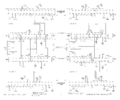129: Difference between revisions
No edit summary |
No edit summary |
||
| Line 1: | Line 1: | ||
[[ | {{Instrument Sidebar | ||
|manufacturer=Tektronix | |||
|model=129 | |||
|class=Mainframe | |||
|series=560-series scopes | |||
|summary=Plugin power supply | |||
|image=Tek_129_front.jpg | |||
|caption=Tek 129 front | |||
|introduced=1964 | |||
|discontinued=(?) | |||
|designers= | |||
|manuals= | |||
* [[Media:070-409.pdf | Tektronix 129 Manual (PDF)]] | |||
* [[Media:Tek 129 1968 catalog.pdf | Tektronix 129 in 1968 Catalog (PDF)]] | |||
* [[Media:Tek 129 training.pdf|Tektronix 129 Training Manual (PDF)]] | |||
}} | |||
The '''Tektronix 129''' is an enclosure and power supply allowing up to four [[560-series scopes|560-series]] plug-ins to be used as freestanding instruments. | The '''Tektronix 129''' is an enclosure and power supply allowing up to four [[560-series scopes|560-series]] plug-ins to be used as freestanding instruments. | ||
The 129 has a fan and a 150 °F (65 °C) [[thermal cutoff]]. | The 129 has a fan and a 150 °F (65 °C) [[thermal cutoff]]. | ||
Each plug-in bay in the 129 has an output circuit card. The deflection signal output on pins 17 and 21 of the plug-in | Each plug-in bay in the 129 has an output circuit card. The deflection signal output on pins 17 and 21 of the plug-in drive the output circuit card. | ||
drive the output circuit card. There are two varieties of output circuit card: active (cathode-follower) and passive. | There are two varieties of output circuit card: active (cathode-follower) and passive. | ||
To use [[sampling oscilloscope|sampling]] plug-ins in the 129, active output circuit cards are required. | To use [[sampling oscilloscope|sampling]] plug-ins in the 129, active output circuit cards are required. | ||
The power supply of the 129 is linear and consists of a power transformer followed by silicon rectifiers, electrolytic | The power supply of the 129 is linear and consists of a power transformer followed by silicon rectifiers, electrolytic capacitors, and then regulators. | ||
capacitors, and then regulators. Not all of the supply voltages are regulated. A [[ZZ1000]] tube is used as the voltage reference. | Not all of the supply voltages are regulated. A [[ZZ1000]] tube is used as the voltage reference. | ||
The regulators (feedback amplifiers and output tubes) are all tube, except for the high-current −12.2 V regulated supply. This one | The regulators (feedback amplifiers and output tubes) are all tube, except for the high-current −12.2 V regulated supply. | ||
uses bipolar transistors for the feedback amplifier and output device. The −12.2 V supply is independently fused. The other supplies are | This one uses bipolar transistors for the feedback amplifier and output device. The −12.2 V supply is independently fused. | ||
not independently fused. The 129 has a 6.25 A fuse on the primary of the mains transformer. | The other supplies are not independently fused. The 129 has a 6.25 A fuse on the primary of the mains transformer. | ||
==Pictures== | ==Pictures== | ||
Revision as of 07:55, 16 August 2021
The Tektronix 129 is an enclosure and power supply allowing up to four 560-series plug-ins to be used as freestanding instruments. The 129 has a fan and a 150 °F (65 °C) thermal cutoff.
Each plug-in bay in the 129 has an output circuit card. The deflection signal output on pins 17 and 21 of the plug-in drive the output circuit card. There are two varieties of output circuit card: active (cathode-follower) and passive. To use sampling plug-ins in the 129, active output circuit cards are required.
The power supply of the 129 is linear and consists of a power transformer followed by silicon rectifiers, electrolytic capacitors, and then regulators. Not all of the supply voltages are regulated. A ZZ1000 tube is used as the voltage reference. The regulators (feedback amplifiers and output tubes) are all tube, except for the high-current −12.2 V regulated supply. This one uses bipolar transistors for the feedback amplifier and output device. The −12.2 V supply is independently fused. The other supplies are not independently fused. The 129 has a 6.25 A fuse on the primary of the mains transformer.
Pictures
-
-
-
-
-
-
-
-
-
-
Dimensional drawing
-
Interconnecting sockets
-
Power supply
-
Passive circuit card
-
Cathode follower card
-
Output and monitor circuit















